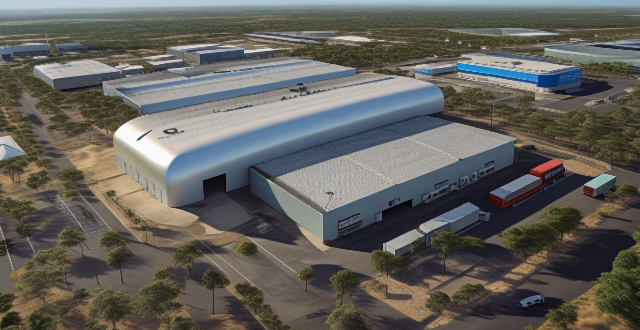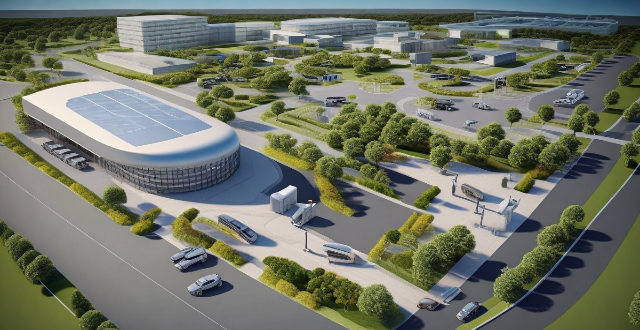Data Station

How do communication satellites enable real-time data transmission and monitoring ?
Communication satellites play a crucial role in enabling real-time data transmission and monitoring by serving as relay stations in space that can receive signals from one location on Earth and transmit them to another location. This is achieved through a complex system of technology, infrastructure, and protocols. Satellites are positioned in orbits around the Earth, either in geostationary orbit (GEO) or lower Earth orbit (LEO). Geostationary satellites remain fixed over a specific point on the Earth's surface, while LEO satellites move relative to the Earth's surface. The process begins when a signal, such as a phone call, internet data, or video feed, is generated at a source location. The signal is then sent via a ground station, which has powerful transmitters and antennas, up to the communication satellite using radio waves. Once the satellite receives the signal, it amplifies and frequencies it to avoid interference with other signals. The amplified signal is then transmitted back down to Earth, where another ground station receives it. Finally, the received signal is distributed to its intended destination, such as a phone network, the internet, or a monitoring station. Real-time monitoring is facilitated by the speed at which data can travel via satellite. With modern technology, latency (the time delay in signal transmission) can be minimized, especially with LEO satellites due to their closer proximity to Earth. Satellites can also be networked to provide redundancy and increased bandwidth for large-scale monitoring systems. Key technologies and infrastructure include ground stations, satellite design, network protocols, and satellite constellations. However, there are challenges and considerations such as weather impact, geographical constraints, and regulatory issues. In summary, communication satellites enable real-time data transmission and monitoring by acting as high-altitude relay stations, utilizing advanced technologies and infrastructure to deliver signals across vast distances with minimal delay.

How long does it take to build a charging station, and what are the requirements ?
Building a charging station can take anywhere from a few weeks to several months, depending on various factors such as the size and complexity of the project, the availability of equipment and materials, and local regulations and permits required. The process involves site selection, obtaining necessary permits and complying with regulations, ensuring a reliable source of electricity, procuring equipment, installing infrastructure, integrating software systems, testing and commissioning, establishing maintenance and support plans, promoting the new station, and continuously monitoring and optimizing its performance.

How do communication base stations work ?
Communication base stations, or cell towers, are vital for wireless networks. They consist of antennas, transceivers, controllers, and power supplies to transmit and receive signals. The process includes encoding user data, modulating it onto RF waves, transmitting via antenna arrays, receiving by mobile devices, and decoding back to the original format. Coverage areas depend on antenna height, power, and topography, while handover processes ensure seamless transitions between base stations. Connected to a core network via backhaul links, base stations enable voice calls, messages, and data services, adapting to technological advancements to meet increasing demands.

What are the benefits of using a super fast charging station ?
Using a super-fast charging station for electric vehicles offers benefits including time efficiency, convenience, battery health optimization, environmental considerations, economic benefits, and improved user experience. These charging stations enable rapid recharging, reduce range anxiety, optimize battery lifespan, support the use of renewable energy sources, lower operational costs, and provide peace of mind for EV drivers. As technology advances, further improvements in charging infrastructure are expected to enhance these advantages.

What is the range of a typical communication base station ?
The typical communication base station, also known as aThe typical communication base station, also known as a specific geographic area with wireless The range of a base station can vary based on the type of technology used, the height and location of the tower, and the surrounding environment. Different technologies have different range capabilities, with newer ones like 4G and 5G offering greater coverage and capacity than older technologies like 2G. Tower height and location also play a significant role in determining its range, with taller towers covering wider areas and being less affected by signal blockage. The surrounding environment, including urban or rural areas, can impact the range of a base station. The typical range of a base station can be from a few hundred meters to several kilometers, with practical ranges often being smaller due to interference and other factors. Network operators may use multiple base stations and other techniques to optimize coverage and capacity within their service areas.

Are there any safety concerns with using a super fast charging station ?
The text discusses the safety concerns associated with using a super fast charging station, such as potential damage to the battery and risk of overheating. It also highlights other safety concerns like electrical shock, poor quality chargers, and overcharging. The text emphasizes the importance of taking proper precautions and following safety guidelines to minimize these risks.

What is the average cost of using a super fast charging station ?
The average cost of using a super fast charging station can vary depending on several factors, such as location, time of day, and type of vehicle. Urban areas tend to have higher prices due to increased demand and limited availability of charging infrastructure, while rural or less populated areas may offer lower rates. Many charging stations implement time-of-use pricing, with off-peak hours during late night or early morning being cheaper than peak hours during rush hour traffic. The size of your electric vehicle's battery and its maximum charging capacity can also affect the overall cost, with larger batteries requiring more energy to charge and potentially resulting in higher costs. The estimated range for the average cost of using a super fast charging station is $0.20 - $1.00 per kWh, but actual costs may vary widely depending on local conditions and specific charging providers.

How long does it take to fully charge an electric vehicle at a super fast charging station ?
Electric vehicle charging times vary based on several factors such as battery capacity, charging power, battery state of charge, and temperature. Super fast charging stations can charge small city cars from 0% to 80% in about 20-30 minutes, mid-size sedans in approximately 30-45 minutes, and large SUVs in around 45-75 minutes. Tips for optimizing charging time include planning trips, using apps to find available charging stations, avoiding peak hours, monitoring battery level, and considering warm-up features in cold weather.

What is a communication satellite and how does it work ?
Communication satellites are vital for global telecommunication, relaying signals for phone calls, internet data, and TV broadcasts between Earth-based stations. They operate by receiving, amplifying, and retransmitting signals from one location to another through a series of steps involving transmission, reception, amplification with frequency conversion, and retransmission. Most occupy geostationary orbit to maintain a fixed position relative to Earth, simplifying ground station antenna targeting. These satellites cover extensive areas, support diverse applications like broadcasting and emergency response, and often form part of larger networks ensuring global connectivity. Their role is crucial in international business, disaster relief, and personal communications worldwide.

How do communication base stations affect the quality of phone calls and internet speeds ?
The article discusses the impact of communication base stations on phone call quality and internet speeds. It covers factors such as signal strength, coverage area, network congestion, spectrum availability, and technology used in base stations. The article explains how these factors affect voice and data services, and suggests solutions to address network congestion and improve performance.

How does a super fast charging station work ?
Super fast charging stations rapidly charge electric vehicles (EVs) using complex technology involving multiple components. The power supply, charging equipment, and battery management system (BMS) are key elements in the process. The BMS monitors and controls the charging to ensure safety and efficiency. Challenges include potential impacts on battery health, infrastructure costs, and standardization issues across different EV models. As EV popularity increases, advancements in super fast charging technology will be vital for convenience and accessibility.

What is the future of super fast charging stations in the automotive industry ?
The future of super fast charging stations in the automotive industry is promising, driven by increased demand for EVs, technological advancements, government initiatives, and collaboration between stakeholders. These stations will become integral to smart grids, expand into new markets, and improve user experience through innovation in design and maintenance.

What is data privacy ?
Data privacy is the protection of personal information from unauthorized use. It's important for individual rights, building trust, legal compliance, and risk mitigation. Principles include data minimization, anonymization, encryption, transparency, consent, access control, retention, integrity, and accountability. Best practices involve regular audits, employee training, updating policies, secure systems, and response plans for data breaches.

What is the cost of building and maintaining a communication base station ?
The article discusses the costs associated with building and maintaining a communication base station, categorizing them into initial setup costs such as site acquisition, design and engineering, equipment procurement, construction and installation, permits and licensing, and testing and commissioning, and ongoing maintenance costs like rent or lease expenses, power consumption, equipment maintenance, software updates, security measures, and staff salaries. It emphasizes the complexity of these processes and the importance of careful planning and budgeting for such projects.

How do super fast charging stations compare to traditional gas stations in terms of convenience and efficiency ?
Super fast charging stations offer greater convenience and efficiency compared to traditional gas stations. They are strategically located, offer faster charging speeds, provide multiple payment options, consume less energy, and have a lower environmental impact.

What are the health risks associated with living near a communication base station ?
Living near a communication base station, such as a cell tower or a radio mast, has raised concerns about potential health risks. While the scientific evidence is still being debated, there are several possible health effects that have been suggested by some studies and expert opinions. Here are some of the key health risks associated with living near a communication base station: - Electromagnetic Radiation Exposure: Increased exposure to electromagnetic fields (EMFs) and possible long-term effects on health. - Sleep Disruption: Disrupted sleep patterns and chronic sleep deprivation leading to various health issues. - Stress and Anxiety: Heightened stress levels and mental health impacts due to concerns about EMF exposure. - Environmental Impact: Noise pollution and visual pollution affecting both human health and wildlife.

Can all electric vehicles use a super fast charging station ?
Electric vehicles (EVs) follow different charging standards and protocols that dictate the speed at which they can be charged. The type of battery technology used in an EV also affects its compatibility with super-fast charging, as some batteries may not be able to handle the high power output without damage or reduced lifespan. Manufacturers design their vehicles to work best with specific charging infrastructure, and not all EVs are equipped to take full advantage of super-fast charging. Safety concerns related to heat generation during super-fast charging must also be considered. Therefore, it is essential for EV owners to understand their vehicle's capabilities and limitations when it comes to charging options.

How does data encryption affect computer performance ?
Data encryption is crucial for securing data but can affect computer performance by increasing processor load, memory usage, disk I/O, network latency, and reducing battery life.

Why is data encryption important for online security ?
Data encryption is crucial for online security, protecting dataData encryption is crucial for online security, protecting data the financial impact of breaches It has evolved from ancient uses to a critical tool in today's digital landscape, with AI optimizing key management and enhancing algorithms.

How many super fast charging stations are needed to effectively support the growing number of electric vehicles on the road ?
The number of super fast charging stations needed for electric vehicles depends on factors like vehicle range, driving habits, charging speed, and network density. A rough estimate suggests one station per 50-100 vehicles, but this should be adjusted based on local conditions and specific requirements.

What are the benefits of having an unlimited data plan ?
An unlimited data plan offers benefits such as no data caps or overage charges, the ability to stream videos and music without worrying about data usage, using multiple devices simultaneously, working from anywhere, enjoying online gaming and social media, and better value for money.

How do data protection regulations handle sensitive personal data ?
Handling sensitive personal data under data protection regulations requires strict adherence to principles such as consent, minimization, purpose limitation, and security. Regulations like the GDPR in the EU, CCPA in the US, and PIPEDA in Canada impose specific conditions for processing sensitive information. Organizations must adopt best practices including assessment, privacy impact assessments, employee training, access controls, and monitoring to ensure compliance and protect individuals' privacy rights.

What is the difference between data privacy and data protection ?
The text discusses the difference between data privacy and data protection, emphasizing that understanding these concepts is crucial for managing personal information responsibly. Data privacy focuses on individual rights to control personal information, while data protection emphasizes organizational measures to safeguard that information. Both are essential for building trust and ensuring responsible data handling.

What role do data protection officers play under data protection laws ?
Data protection officers (DPOs) are crucial for ensuring compliance with data protection laws in organizations. They advise on compliance, develop policies, ensure adherence to regulations, educate stakeholders, and act as a point of contact for personal data requests.

Can data encryption prevent data breaches and cyber attacks ?
Data encryption is a crucial security measure that can significantly reduce the risk of data breaches and cyber attacks by converting plain text into an unreadable format. However, it does not completely eliminate the risk of data breaches and cyber attacks. Encryption works through complex algorithms to scramble data so that it appears as random characters, requiring a secret key (or password) to decrypt the data back into its original form. There are two main types of encryption: symmetric and asymmetric. While encryption offers benefits such as confidentiality, integrity, authentication, and non-repudiation, it also has limitations including key management challenges, performance overhead, compatibility issues, human error, and advanced persistent threats (APTs). Therefore, organizations should implement other security measures such as firewalls, intrusion detection systems, regular security audits, and employee training programs to minimize the risk of cyber threats.

How do unlimited data plans differ from traditional data plans ?
Data plans are essential for internet usage, with unlimited and traditional data plans being the main types. Unlimited plans offer no data limits, predictable costs, and suit heavy users, while traditional plans have data limits, variable costs, and suit light users. The key differences include data limits, cost, and usage scenarios. Choosing the right plan depends on individual needs and usage patterns.

What is data encryption and how does it work ?
Data encryption is a crucial cybersecurity measure that transforms plaintext into ciphertext, protecting it from unauthorized access. It involves the use of complex algorithms and secret decryption keys. Encryption is significant for securing data at rest, in transit, and during processing, helping meet compliance requirements and reducing financial risks associated with data breaches. Its evolution includes historical precursors and wartime innovations, with AI expected to enhance its capabilities in the future.

What happens to my data during an iPhone repair ?
When you send your iPhone for repair, the repair center will take several steps to protect your data, including diagnostics, backup, data protection, testing, verification, and return of your device.

How many communication base stations are needed to cover a city ?
This article discusses the factors affecting the number of communication base stations required for a city, including city size and population density, topography, and building height. It also provides an estimate formula to calculate the number of base stations needed based on city area and coverage per station. The conclusion emphasizes the importance of considering these factors in network planning and deployment to ensure reliable communication services across the city.

What are the rules regarding data breaches under data protection regulations ?
Data protection regulations have been established to ensure the confidentiality, integrity, and availability of personal data. These regulations set out specific rules regarding data breaches that must be followed by organizations that handle personal data. The key rules regarding data breaches under data protection regulations include notification of data breaches, mitigating their impact, record-keeping and reporting, penalties for non-compliance, and best practices for preventing data breaches. By adhering to these rules and implementing best practices, organizations can reduce the risk of data breaches and protect individuals' personal data.